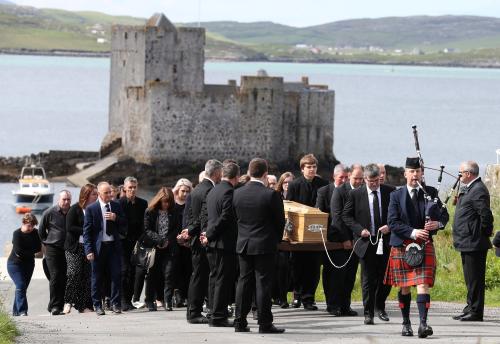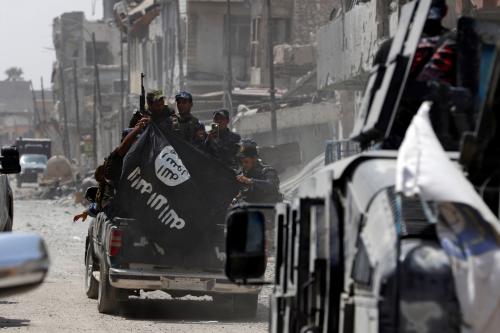Dan Byman writes that the U.S. decision to withdraw from Syria is likely to increase attacks orchestrated or inspired by ISIS in Europe. This piece first appeared in Vox.
With the surprise withdrawal of U.S. forces in Syria and the subsequent — and immediate — commencement of Turkish military operations against Syrian Kurdish forces, chaos has ensued. Kurdish forces are claiming that hundreds of ISIS prisoners have escaped at the Ain Issa detention facility while fighting raged nearby, while two officials told the New York Times that the U.S. military had failed to secure 60 or so high-value detainees before its forces departed.
President Donald Trump, however, has assured Americans that his new approach would not prove a threat to the U.S. homeland, saying, “They’re going to be escaping to Europe.”
Europeans, to be sure, will not find this reassuring. Given the thousands of Europeans who went to fight for the Islamic State and the problems Europe has had with jihadist terrorism in general, they should be alarmed by the U.S. abandonment of the Syrian Kurds and the possible escape of large numbers of ISIS prisoners. The good news is that the potential threat illustrates the counterterrorism progress made in the years since 9/11, but the end of the U.S. role in Syria is clearly bad news.
Europe has a painful record when it comes to jihadist terrorism, suffering repeated mass casualty attacks in the post-9/11 era, including an ISIS-orchestrated set of strikes in Paris in 2015 that killed 130 people. European states, however, have made strides on this front, bolstering intelligence collection and sharing, toughening up their laws, and otherwise improving counterterrorism measures. The latest crisis in Syria highlights the need for Europe to continue its aggressive counterterrorism policies, improve how it handles terrorists in jail, and develop a more coherent set of policies to handle suspected terrorist detainees.
A history of violence and radicalism
Europe’s response to jihadist terrorism has long been uneven — often dramatically so. France, which suffered repeated attacks on its soil from the Algerian civil war in the mid-1990s, adopted an aggressive counterterrorism program, and its intelligence service went from clueless to superb as the decade wore on. The United Kingdom preferred to keep the jihadists close in the 1990s, allowing London to become a home for dissidents and propagandists of all sorts, many of whom encouraged young Muslims to fight in Bosnia, Chechnya, and other places with insurgent battlegrounds.
The British hope was that by monitoring them and allowing a safety valve, they could control the dangers. Other countries — such as Belgium, Germany, and Italy — simply ignored the problem. The jihadists, after all, seemed focused overseas, and the attacks on France could be waved off as an Algeria-specific problem that was a bitter legacy of French colonialism.
For some countries, 9/11 represented a change. The sheer scale of the devastation opened eyes to the risk of terrorism at home. For others, a more aggressive counterterrorism posture seemed an easy way to appease the United States, which saw the fight against Al Qaeda as the world’s top security concern.
But the resulting greater pressure on European jihadist networks, and the participation of some European states in the military campaign in Afghanistan, angered the jihadists and proved, in their eyes, the enmity of Europe. Al Qaeda in particular began to turn the networks developed to export foreign fighters from Europe into operational nodes to attack the continent. The 2004 Madrid bombings and the 2005 London attacks, which killed 191 and 52 people respectively, were bitter fruits of this shift. Even tiny Denmark was at risk after a Danish newspaper published cartoons mocking the Prophet Mohammed, leading to repeated threats against the country. In 2015, jihadists would kill 12 staff members of the satirical magazine Charlie Hebdo in Paris for its insults to the prophet.
In the face of this violence, Europe continued to improve, albeit fitfully. Those touched directly by the threat, such as the United Kingdom and Denmark, initiated crackdowns and an array of programs, ranging from intelligence collection to efforts to “combat violent extremism” — using social programs and improving community ties to decrease the alienation of Muslim communities. Europe also expanded intelligence sharing among its members and with the United States.
Complicating the efforts of European security services, Europe also has an array of radical networks that seek the imposition of Islamic law and are hostile to the values and legitimacy of European governments. Al Muhajiroun, which was active in the United Kingdom until the 2005 crackdown and whose successors remain active, was linked to 25 percent of the U.K. terrorism convictions between 1998 and 2015. An Al Muhajiroun leader even radicalized one of the 2019 Sri Lanka Easter bombers. Other European countries had similar, if less potent, organizations like Sharia4Belgium and Sharia4Denmark. These organizations create networks among like-minded radicals — at home, throughout Europe, and abroad in the Muslim world — that can easily be co-opted by their violent members.
Despite this long history, many European states found themselves overwhelmed by the flow of foreign fighters and the wave of terrorism that swept Europe during the Syrian jihad. Some of this was related to the staggering scale of the foreign fighter flows. Almost 6,000 European Muslims traveled to fight in Syria, compared with around 700 between 1990 and 2010 to Afghanistan, Bosnia, Chechnya, and Iraq combined.
The tide began to turn in 2015. The United States, working with France and the United Kingdom and other European countries, partnered with the Iraqi government, local Iraqi militias, and the Syrian Kurds to fight ISIS, with the group’s other enemies, such as Iran, also playing important roles. Slowly, but steadily, the once-mighty caliphate shrank, and by 2019 ISIS no longer controlled territory. Many of the foreign volunteers died in the fighting, but thousands found themselves in prison camps in Iraq or run by Syrian Kurds. There they lingered, with the Kurds (unlike the Iraqis) reluctant to execute them, but with most European states unwilling to repatriate their nationals.
The steady destruction of the above-ground ISIS caliphate seems to have been a boon to Europe; both the number of terrorist attacks and total fatalities have fallen in recent years. In Europe, 14 people have died from jihadist terrorism in 2018, a steep fall from 2015, when attacks in Paris and elsewhere led to 150 deaths.
Beyond the falling death toll, the biggest sign of success is the diminished role of foreign fighters. Those who had fought in foreign wars played a dominant role in European terrorism in the post-9/11 era but now, as a Danish intelligence report notes, “Attacks in Europe are overwhelmingly committed by lone individuals who have not been to a conflict zone.” Most of the European foreign fighters either died in Iraq and Syria, were detained there, kept on fighting underground, or were arrested upon return. Either way, the wave of attacks that analysts feared a couple of years ago did not materialize.
But the Syrian Kurds are now focusing on the Turkish military, and it is likely that ISIS prisoners are escaping already. Even a small number of hardened, dedicated fighters could pose a major terrorism threat; research has proven they are far more lethal. The Islamic State is highly opportunistic, and it will use the ensuing chaos and distraction of its enemies to reconstitute itself, increasing the danger of international terrorism as well as local violence.
The European dragnet, though, is stronger than it once was
One bit of good news is that Europe’s earlier problems with terrorism stemmed, in part, from a series of self-made failures, several of which have been corrected. When the Islamic State emerged in 2012-’13, some intelligence services simply had their eyes closed. Others were woefully underfunded. Thus they failed to detect the problem before it grew beyond their control.
The Dutch intelligence service at first believed the Netherlands had few domestic radicals and only in hindsight realized that 2013 represented a banner year for recruitment, when almost 100 volunteers went to Syria. In the Hague, Islamic State supporters, often affiliated with groups like Sharia4Holland, brandished the Caliphate’s black flag in demonstrations, called for the death of “dirty Jews,” and discussed openly on Twitter and Facebook the call to make jihad.
Ignoring Europe’s own history with foreign fighters, many local authorities often at first secretly smiled as these volunteers, many troublemakers or criminals, left for the Caliphate. Their departure led to a fall in crime and, some officials hoped, would remove a potential source of radicalism. As French officials made it clear to me in 2014, “it is not a concern if they die there — only if they come back.”
But the 2015 Paris and Brussels attacks revealed gaping holes in Europe’s counterterrorism net: Lists of suspects were often not shared, and different countries used different systems of transliteration, hindering basic data searches. Even for countries with effective security services like France, vulnerability was still high, as less proficient neighbors like Belgium create de facto havens where terrorists face far less pressure. Many European states did not have laws criminalizing participation in foreign wars on behalf of a terrorist group. The same weak legal codes hindered the prosecution of both departing and returning foreign fighters. Indeed, some fighters ended up in extralegal detention because their home countries lacked appropriate criminal authorities to handle their cases.
European states have become more aggressive and many of these problems have diminished, which will make it harder for escaping European foreign fighters to wreak havoc. Security services are far better resourced and, after the wake-up calls of Paris in 2015 and Brussels in 2016, more focused on the present danger.
Belgium, for example, arrested returnees from Iraq and Syria upon stepping back in country and developed an array of community-based programs to monitor them and dissuade them from returning to violence. Intelligence sharing is also far stronger. Some states, notably France and the United Kingdom, also sought to kill their own nationals in the Syrian war zone, diminishing the threat to their homes by action overseas. France, for example, provided a hitlist of 30 high-value targets to Iraqi soldiers.
Europe, as a whole, also toughened up its laws. U.N. Resolution 2178 demanded states take action to stop foreign fighters from joining up with terrorist groups and Resolution 2396 focused on stopping terrorist travel. A number of European states link their domestic laws to U.N. resolutions, and thus gave states the impetus to crack down at home and cooperate more abroad.
Another problem: Transit to and from Syria remained easy. Part of this was due to the lax policies of Turkey, which until 2015 tolerated the flow of foreigners to Syria as part of its overall campaign to unseat President Bashar al-Assad by supporting an array of opposition forces. This gave jihadists easy access to the war zone from Europe and vice versa. When in 2015 Ankara began to crack down at home and secure its border with Syria, ISIS was dealt a major blow.
Given Turkey’s expanding role in Syria in the wake of its invasion of Kurdish territories, European states will depend on it even more. First, Turkey may take over some prison camps or otherwise become a large-scale jailor of Islamic State members, though the reports of prison escapes are discouraging on this score. Second, it will remain an important potential transit point to Europe. In both cases, Turkey’s actions — or inactions — will shape the scale of the terrorist threat to Europe.
Three key counterterrorism needs
With Syria again in flux and the possible return of many foreign fighters, European states need to continue to resource their security services and otherwise prepare for violence. Part of this necessity is also due to a growing back and forth between right-wing extremism and jihadist violence, where the jihadist attacks are used by white supremacists to justify attacks on Muslims — a circle that must be broken.
Europe also needs longer jail times for those convicted of terrorism-related crimes. Too often, individuals are sentenced to short jail terms. In the United States, the average prison sentence for jihadist-linked terrorism is almost 15 years; in Europe, sentences are usually only a few years, leading to a revolving-door problem.
As a result, individuals are often still at a prime age for jihadist recruitment in jail and for violence when they leave incarceration. Indeed, given the large number of radicals in jail, there is a danger that they will become more radical or radicalize others. Jail, in other words, risks making the problem worse. Some European states have made progress in improving training for prison personnel and developed special prisons for convicted jihadists. Belgium has “satellite prisons” with more monitoring and better-trained staff. Prison staff also receive more extensive training on identifying radicalization, and specialized personnel are present to focus on terrorists.
Third, Europe has tried to outsource the returnee question, including the more than 1,500 children of European origin who went to the Caliphate — or were born there. Dodging this issue has become far more difficult, given the U.S. military withdrawal from Turkey and the Turkish assault on Syrian Kurds.
European states, courting popular opinion, have tried to strip citizenship from dual-passport holders and otherwise shove the responsibility onto others. In addition, they risk sending potential terrorists to countries with weaker legal systems or that otherwise will not properly manage the threat. Most irresponsible is ignoring the children left behind. U.S. Kurdish allies in Syria and Iraqi forces hold hundreds of European children born of Islamic State fighters. Children should be treated as victims rather than as future terrorists: The scholarship done so far indicates little serious risk that they will become terrorists themselves. Abandoning them is a moral failure.
Europe has come a long way since its tolerant and somewhat incompetent approach of the 1990s. Unfortunately, Trump’s policy decisions have increased the terrorism threat Europeans now face, and they are right to worry that attacks orchestrated or inspired by ISIS are more likely. Their governments must grapple with a potentially stronger ISIS in Iraq and Syria and the increased risk of radicals returning home, and they must do so knowing that the Trump administration seems to care little if this happens.
The Brookings Institution is committed to quality, independence, and impact.
We are supported by a diverse array of funders. In line with our values and policies, each Brookings publication represents the sole views of its author(s).











Commentary
Trump’s Syria withdrawal is a boon for ISIS — and a nightmare for Europe
October 15, 2019